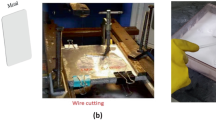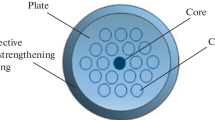Abstract
The inert purge gas plays an important role in mass manufacturing of optical fibers, as it is usually the mixture gas of helium and argon. The natural and forced convective effects of purge gas are numerically investigated through the process simulation of glass fiber drawing in a short draw tower furnace by employing an iterative computational scheme of neck-down prediction formulation and computational fluid dynamics simulation of purge gas flow. The furnace geometric model and process conditions are based on realistic manufacturing process. It is found that neck-down shape and draw tension are quite insensitive to change of gas flow rate and helium contents level. In contrast, the recirculatory flow pattern around preform neck-down region is observed when helium contents are low, suggesting the difficulty in flushing of contamination particles out of furnace system. The increase of helium contents combined with increased flow rate in purge gas mixture could completely remove such undesirable flow patterns.
Similar content being viewed by others
References
K. Richardson, D. Krol and K. Hirao, Glasses for photonics applications, International Journal of Applied Glass Science, 1 (1) (2010) 74–86.
U. C. Paek, Free drawing and polymer coating of silica glass optical fibers, Journal of Heat Transfer, 121 (4) (1999) 1–15.
U. C. Paek and R. B. Runk, Physical behavior of the neck-down region during furnace drawing of silica fibers, Journal of Applied Physics, 49 (8) (1978) 4417–442.
S. H. K. Lee and Y. Jaluria, Simulation of the transport processes in the neck-down region of a furnace drawn optical fiber, International Journal of Heat and Mass Transfer, 40 (4) (1997) 843–856.
S. R. Choudhury and Y. Jaluria, Thermal transport due to material and gas flow in a furnace for drawing an optical fiber, Journal of Materials Research, 13 (2) (1998) 494–503.
X. Cheng and Y. Jaluria, Effect of draw furnace geometry on high-speed optical fiber manufacturing, Numerical Heat Transfer, Part A, 41 (8) (2002) 757–781.
X. Cheng and Y. Jaluria, Optimization of a thermal manufacturing process: Drawing of optical fibers, International Journal of Heat and Mass Transfer, 48 (17) (2005) 3560–3573.
K.-M. Lee, Z. Wei, Z. Zhou and S.-P. Hong, Computational thermal models for design of a modern fiber draw process, IEEE Transactions on Automation Science and Engineering, 3(1) (2006) 108–118.
A. Mawardi and R. Pitchumani, Optical fiber drawing process model using an analytical neck-down profile, IEEE Photonics Journal, 2 (4) (2010) 620–629.
K. Kim, H. S. Kwak and D. Kim, The role of helium/argon gas flow in a glass fiber drawing furnace, Computational Thermal Sciences, 4 (3) (2012) 263–270.
G. G. Carandang, H. S. Kwak and K. Kim, Numerical study and optimization of glass fiber draw furnace in optical fiber manufacturing system, Proc. of 16th International Heat Transfer Conference, Beijing, China (2018) 5635–5642.
Y. K. Kim, J. S. Choi, H. S. Kwak and K. Kim, Numerical modeling and analysis of glass fiber drawing process from large sized silica preform. Journal of Thermal Science and Technology, 12 (2) (2017) JTST0030.
P. Kaiser, Contamination of furnace-drawn silica fibers, Applied Optics, 16 (12) (1997) 701–704.
I. Tsuchiya, S. Ishikawa, M. Saitoh, Y. Ishiguro and H. Kanamori, Furnace for Producing High Purity Quartz Glass Preform, United States Patent, Patent number: US5032079A (1991).
Acknowledgments
This research was financially supported by Basic Science Research Program through the National Research Foundation of Korea (NRF) funded by the Ministry of Education (NRF-2016R1D1A1B03931662).
Author information
Authors and Affiliations
Corresponding author
Additional information
This paper was presented at ICMDT 2019, Shiroyama Hotel, Kagoshima, Japan, April 24-27, 2019. Recommended by Guest Editor Haedo Jeong.
Gia Ginelle Carandang received the B.S. degree in mechatronics from Technological University of the Philippines, Manila, in 2015, and double degree in mechanical system engineering from Kumoh National Institute of Technology, Gumi, South Korea, in 2017. Currently, she is a M.S. degree student in mechanical system engineering and researcher in Applied Heat Transfer Laboratory of Kumoh National Institute of Technology. Her research interests are on computational modeling and mechatronics.
Kyoungjin Kim received the B.S. and M.S. degrees from Seoul National University in 1988 and 1990, respectively, and the Ph.D. degree from The University of Texas at Austin in 1998, all in the academic area of mechanical engineering. He is presently the faculty member of Department of Mechanical System Engineering at Kumoh National Institute of Technology in Gumi, Korea. His research interests are on the numerical modeling of heat transfer phenomena in materials processing and thermal plasma applications.
Rights and permissions
About this article
Cite this article
Carandang, G.G., Kim, K. Numerical investigation on He and Ar gas convective cooling for optical fiber glass drawing at short draw towers. J Mech Sci Technol 33, 5653–5658 (2019). https://doi.org/10.1007/s12206-019-1107-2
Received:
Revised:
Accepted:
Published:
Issue Date:
DOI: https://doi.org/10.1007/s12206-019-1107-2




